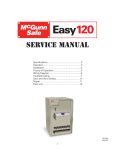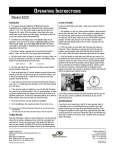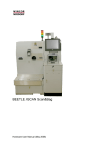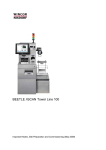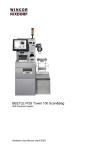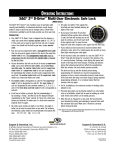Download Easy120V Service Manual
Transcript
Service Manual Specifications......................................................2 Installation...........................................................3 Operation.............................................................4 Programming.......................................................5 Theory of Operation............................................6 Wiring Diagram....................................................7 Troubleshooting...................................................8 Repair................................................................10 Parts List............................................................14 801331 8/2007 1 Easy120V Specifications Footprint — 32”H x 20”W x 20”D Panel Depth — 5” Weight — 270 lbs (approximate empty weight) Boltwork — 5 Point Hinge — Continuous, heavy duty full length Manual Drop — Drawer, 4.5” x 1.5” to key locked inner compartment Validator Drop — Two high quality single-feed validators count money and input bills to a separate key locked inner compartment. Tube Capacity — 120 Tubes (10 columns, 12 tubes/column); Internally loaded Tube Count — Manual fill, auto-decrement Vend Mechanism — Solenoid activated release for hand operated knob cycle vending Vend Delay — 2 Minute default (programmable 0 to 99 minutes) Door Delay — 10 Minute default (programmable 0 to 99 minutes) Users — Master 00 (default PIN 111111) for programming; Users 01 - 99 (4-digit PIN) for operation. Vend Threshold — Default: not set (Limit maximum vend amount per user per period) Armor Car Support — Key override of door delay for instant access Keys — ACO (Armored Car), Manual Drop Inner Compartment, Validator Drop Inner Compartment, Validator Service Door 2 easy120V installation Site Preparation Verify Safe Operation Before installing, make sure there is adequate clearance for the body and base of the safe as well as proper electrical power. 1.Locate the power supply unit packaged inside the unit. Unwrap the power supply. 2.Plug the power supply cable into the power supply jack at the rear of the safe. 3.Plug the standard grounded power plug into a standard 115 VAC outlet. 4.Wait for the display to stabilize (about 10 seconds). 5.Use the OPENING OUTER DOOR procedure to unlock the outer door. 6.Use the VENDING TUBES procedure to operate one column’s vend knob as if a tube were present. 7.Using the VALIDATED DROP procedure verify each validator accepts and counts money. 8.These steps verify operation of critical Easy120V features. If the door or vending system cannot be operated contact McGunn Technical Support immediately and in any event prior to bolting the safe down (1-800-452-4655). Space Requirements Space must be provided for mounting the safe, plus required clearance for access. A minimum gap of one inch must be provided on both sides and four inches at the rear of the safe. Clearance must be provided so that the safe door is allowed to swing open at least 90°. • 1 Inch Side Clearance • 4 Inches Rear Clearance • 90° Door Swing Clearance • Body Height Clearance Power Requirements A standard NEMA 15A 115VAC grounded outlet must be provided within 6 feet of the hinge side of the safe. The unit may share its AC circuit with other point of sale electronic equipment, but must not be on the same circuit as rotating machinery such as a cooler or other refrigeration equipment. • Standard 115VAC Grounded Outlet • No Rotating or Heavy Loads on AC Circuit • Outlet Within Six Feet of Hinge Side Safe Installation 1.Obtain the anchor wedge kit from inside the safe and set aside. 2.Obtain the footprint template (shipped inside the safe). 3.Using a pencil, mark the mounting hole locations on the floor. 4.Drill four 1/2 inch holes to a depth of 3 inches. The holes must be clean. Use a vacuum to clean the holes. Do not use water to clean the holes. 5.Position the safe so that the bolt-holes align with the holes drilled in the floor. While doing so, feed the power supply cable and alarm cable through cabinet openings (if applicable) for routing access. 6.Drive each anchor wedge in until 1/4 inch to 1 inch of the top protrude through the floor of the safe. 8.Slide the washers down over each anchor wedge. 9.Put the nuts on each anchor wedge by hand until finger tight. Turn approximately three to four full turns by wrench to complete the tightening. Installation Procedure Before proceeding, make sure the space and power requirements listed above are met for the mounting location. The safe is shipped with the outer door locked in the open position with rubber bumpers preventing accidental door closure. Remove the Safe From the Pallet 1.Remove wrapping material from the safe. 2.Remove the contents of the safe. 3.Unbolt the safe from the pallet. 3 Operational Overview easy120V Operation Vending Tubes • Most Easy120V operations involve logging in (up to 100 Users supported) using the keypad for security. • The Master User code is used to setup the safe configuration and edit Users. Users 01 to 10 can do all operations shown on this page. Users 11 to 99 are the same except they cannot open the door. • The keypad features an LCD display, four function buttons (F1 – F4), number buttons, a CANCEL button and an ENTER button. The F1/F2/F3/F4 buttons are used to select menu options. • The system tracks the most recent 500 events in the audit history. • Keys are used to operate locks on inner doors, the validator service door, and the armored car switch. • The vending system holds up to 120 tubes and tracks tube inventory. • Two bill validators authenticate and track all money totals through validated drops. • Numerous reports are available to track activity. • Enter your User Number, press ENTER. • Enter your 4-digit PIN, press ENTER. • Select VEND MONEY (F1), enter the COLUMN NUMBER, then press the ENTER button. • Rotate the release knob for the selected column. • Collect your tube of change from the dispensing tray. • Tube count automatically subtracts tubes as they are vended. • The vend delay must be satisfied before you may vend again. Checking Tube Count • • • • Loading Tubes • The outer door must be open to load tubes. Refer to the DOOR OPERATION – NORMAL procedure below. Tubes may be inserted with the open end facing either way. If you track tube inventory you must tell the system at the time you open the door how many tubes are going to be loaded into the vend system by the time you’re ready to close the door. Manual Drops • A manual drop drawer is provided for making secure drops of cash. • Pull out the drawer, insert money, close drawer. • The money falls into a phish-resistant isolated locked inner compartment. • To remove manual drop money, open the outer door and use your manual drop key to open the compartment. About Reports • The CASH ON HAND Report shows the total money in the validated drops and the vending system. • The GRAND Z Report shows total net activity (money loaded, vended, and dropped via validators) since the previous GRAND Z was run (usually the previous day); this report also provides a complete audit history since the previous GRAND Z was run. Running a GRAND Z report resets all net activity to zero. • The GRAND X report is identical to a GRAND Z report except it does not reset net activity. • The USER Report lists all User Numbers enrolled in the safe. • The PREVIOUS CASH Report reprints the last CASH ON HAND Report. • The PREVIOUS Z Report reprints the last GRAND Z Report. • The DEPOSIT Report prints automatically whenever the door is opened and you select to remove validated drop cash. • DROP Receipts print automatically whenever you make a validated drop. Validated Drops • • • • • • Enter your User Number, press ENTER. Enter your 4-digit PIN, press ENTER. Select VAL. DROP (F4 or F4 then F2 as directed). Insert bills into validators. Press the CANCEL button to end the drop. A Drop Receipt will print automatically showing the total dropped. Door Operation – Normal • • • • • • • • Enter your User Number (01 to 10 only), press ENTER. Enter your 4-digit PIN, press ENTER. Select OPEN DOOR (F2). If a delay is set, wait until the delay ends on the screen. You then have up to five minutes to repeat the above steps. If you are emptying the contents of the validated drop compartment press F1 to reset the validated cash total and print the Deposit Report for bank deposit, otherwise press F2. IMMEDIATELY turn the handle and open the outer door. If you are loading tubes, immediately press F1 and follow the instructions on the screen to tell the system how many tubes will be loaded into each column. Use your inner compartment keys to open manual or validated drop doors as needed. Load tubes if applicable. Printing Reports • Enter your User Number, press ENTER. • Enter your 4-digit or 6-digit PIN, press ENTER. • MASTER User only: Select NO (F2) to PROGRAM SAFE?. • Select PRINT REPORTS (F3 or F4 then F1). • Select the desired report as directed. • Collect your report from the printer. Door Operation – Armor Car Access Insert and turn the Armored Car Key. IMMEDIATELY turn the handle and open the outer door. A Deposit Report will print automatically. Use your inner compartment keys to open manual or validated drop doors as needed. • Note: Using the Armored Car Access procedure does not allow you to enter new tube inventory totals. Enter your User Number, press ENTER. Enter your 4-digit PIN, press ENTER. Select COLUMN BALANCE (F2 or F3 as directed). Enter the number of the column to check and press ENTER. The balance will be displayed. Repeat as needed. • • • • 4 easy120V programming About Users Setting Vend Delay • The Master User (00) has a 6-digit PIN. This code is used for programming and running reports only. • Users #01 to #10 have a 4-digit PIN and may: vend tubes, check the balance in vend, make validated drops, run reports and open the door. • Users #11 to #99 have a 4-digit PIN and may: vend tubes, check the balance in vend, make validated drops, and run reports. • The vend delay is the delay period following a vend you must satisfy before you may vend again. The purpose of a vend delay is to minimize financial loss during an armed robbery. • Enter User Number 00, press ENTER. • Enter your 6-digit PIN, press ENTER. • Select YES (F1) to PROGRAM SAFE? • Select VEND DELAY (F4, F2). • Enter the desired vend delay value (in minutes) and press the ENTER button. Editing the Master User • The factory default Master User PIN code is 111111 and should be changed immediately following installation. This code may be changed at any time but cannot be eliminated. If you lose this code, contact McGunn Technical Service for assistance with recovering it. • Enter User Number 00, press ENTER. • Enter your 6-digit PIN, press ENTER. • Select YES (F1) to PROGRAM SAFE? • Select MASTER PIN (F1). • Enter your current Master User PIN and press the ENTER button. • Enter your new Master User PIN and press the ENTER button. Setting Vend Threshold • The Vend Threshold limits the maximum dollar amount any one user may vend in a specified period. You define the amount and the period. • Enter User Number 00, press ENTER. • Enter your 6-digit PIN, press ENTER. • Select YES (F1) to PROGRAM SAFE? • Select VEND THRESHOLD (F4, F3). • Enter your desired dollar limit and press the ENTER button. • Enter the time period (in minutes) and press the ENTER button. Editing Users 01 To 99 Setting Door Delay • • • • • Enter User Number 00, press ENTER. Enter your 6-digit PIN, press ENTER. Select YES (F1) to PROGRAM SAFE? Select USER PIN (F3). Enter a USER NUMBER then select ADD (F1) or DELETE (F2). • If you chose to ADD: Assign a 4-digit PIN code and press the ENTER button. You cannot assign the same PIN code to more than one user. If you select a user who is already enrolled this effectively changes the User’s PIN code. • The door delay is the delay period you must satisfy before opening a door (see also DOOR OPERATION – NORMAL above). Door delays are intended help protect against loss of money and life from an armed robbery. • Enter User Number 00, press ENTER. • Enter your 6-digit PIN, press ENTER. • Select YES (F1) to PROGRAM SAFE? • Select DOOR DELAY (F4, F4, F1). • Enter the desired door delay value (in minutes) and press the ENTER button. Unit ID Number Zero Vend Balance • This is a four digit number and it prints on all reports. “Unit” refers to the store number. • Enter User Number 00, press ENTER. • Enter your 6-digit PIN, press ENTER. • Select YES (F1) to PROGRAM SAFE? • Select PROGRAM UNIT (F2). • Enter your unit number and press the ENTER button. • • • • • • Setting Column Values Use this procedure to reset all column totals to zero. Enter User Number 00, press ENTER. Enter your 6-digit PIN, press ENTER. Select YES (F1) to PROGRAM SAFE? Select ZERO SYSTEM (F4, F4, F2). Press F1 to verify system tube count reset to zero. Setting the System Clock • Use this procedure to set the “per tube” value for each column. • Enter User Number 00, press ENTER. • Enter your 6-digit PIN, press ENTER. • Select YES (F1) to PROGRAM SAFE? • Select COLUMN VALUES (F4, F1). • Select the column to set and press the ENTER button. • Enter the new value and press the ENTER button. Repeat these last two steps as needed. • • • • • • 5 Enter User Number 00, press ENTER. Enter your 6-digit PIN, press ENTER. Select YES (F1) to PROGRAM SAFE? Select DATE AND TIME (F4, F4, F3). Select TIME (F1) and enter the correct time as directed. Select DATE (F2) and enter the year, month and day as directed. Easy120V theory of operation keypad vending display validating To load tubes the outer door must be open. Tubes may be loaded with the open end facing in or out. 12 tubes may be loaded in each column. When a user performs a vend the main circuit board energizes the solenoid for the selected column until either a tube is detected dropping or it times out (about 7 seconds). An optical sensor beam passing under the vend assembly detects tubes dropping from the assembly to the tray area. When this beam is interrupted the main circuit board turns off the solenoid. The keypad is actually a membrane surface. It attaches to the slanted face of the door panel with self-adhesive. It connects by ribbon cable to the main circuit board. To the right of the display window is a standard number pad with buttons for digits 0 to 9 plus “Enter” and “Cancel” buttons. Four Function buttons (F1, F2, F3, F4) are positioned in a row immediately below the display window. The Function buttons are used to select menu items presented on the display screen. When a user logs in and chooses to make a validated drop the main circuit board sends a signal to the bill validators to turn on and accept money. As bills are fed into the validators, the validators send information about the bill count and denominations back to the main circuit board. It tracks the total money dropped, who made the drop, and the time. When the drop is complete a receipt is generated at the printer. Bills are only accepted when the validators are enabled in this manner. An LCD display is located near the center of the keypad. It is visible through a clear window in the surface of the keypad membrane. The display circuit board is mounted to the underside of the door panel. outer door lock The outer door lock is activated by a control signal from the main circuit board. Users may open the door using normal door procedures or using the Armored Car Override key switch. Accounting The processor on the main circuit board tracks all bill validator and vending financial activity. Validator money tracking is completely automatic. Daily “Grand Z” reports allow you to track validated drop activity by business day. Each time the outer door is opened you have the option of resetting the total cash in validated drops to zero. You also have the option to set the number of tubes loaded into each column. ACO KeySwitch This switch is used to send a control signal to the main board telling it to immediately unlock the outer door. programming All programming is done using the keypad and display on the outer door panel. The configuration is saved to nonvolatile memory on the main circuit board. To configure the safe you must use User 00. Refer to the EASY120V PROGRAMMING section for more information about how to program the safe. 6 Easy120V wiring diagram LCD DISPLAY MODULE KEYPAD MEMBRANE ACO DOOR PANEL VALIDATOR 1 J23 J5 J29 VALIDATOR 2 HEARTBEAT J2 J25 J3 1 2 3 4 5 6 7 8 J4 S2 J26 10 9 8 7 6 5 4 3 2 1LOCK VEND SOLENOIDS J21 LOCK VEND DROP SENSOR TRANSMITTER VEND DROP SENSOR RECEIVER ARMORED CABLE (TO BACK PANEL) Easy120V Wiring Diagram Vend Solenoids: Blue wire pairs to associated J7 connector. Lock: Orange and Black (top two wires of RJ45 at lock) to J7 LOCK1 connector. Vend Drop Sensor Transmitter: Yellow and Black wire harness to J21. Vend Drop Sensor Receiver: Yellow, Black, and Yellow wire harness to J25. Armored Cable: Red, Blue, and Black (power) to J26; Red and Black (+5V power) to LCD module, Blue and Black (+12V power) to validators, Gray harness (printer) to J4. Validators: Black, White, and Orange sets to J2 (channel 1) and J3 (channel 2). ACO Key Switch: Red and black wires to J29. LCD Module Data: Flat ribbon cable to J23. Keypad Membrane: Flat ribbon cable to J5. 7 Easy120V troubleshooting introduction Most problems will fall into one of these categories: mechanical/door operation, vending, power, or electronics. If you can successfully determine the nature of the problem you can greatly reduce the number of possible causes. PIN 1 = Black, Common PIN 3 = Red, +5 VDC Power If the unit has no power, the display will be off and there will be no response from the keypad. PIN 5 = Blue, +12 VDC External Power The unit is powered by an external DC power supply (Part 15000346). Measure the output voltage to determine power supply operation up to the back of the safe (only +12 and +5 VDC and common are used). If the problem is external verify the outlet has power and replace the power supply if faulty. If the power supply output is good and everything is conencted properly, the problem is inside the safe. 1 3 4 2 5 Power and Printer Interior Connection to Back Panel Vending 1 = COM 2 = COM 3 = +5 VDC 4 = –12 VDC 5 = +12 VDC Vending problems may include tube jams, solenoid problems, vend drop sensor problems, or electronics problems. Tube Jam or Empty Column Open the door and visually inspect to make sure there are tubes in the column and there is no jam. If the column is jammed clear the jam. Power Supply Output Internal Power Solenoid or Main Board Internally power runs on multiple sets of wires from the rear of the safe through an armored cable to the door. Through the armored cable: black wires carry power common from Pin 1 of the jack to J26 (main board), the LCD module, and validators; blue wires carry +12 VDC from Pin 3 on the jack to J26 on the main board and both validators; red wires carry +5 VDC from Pin 5 of the jack to the LCD module and main board J26. The armored cable also carries the printer cable harness. While attempting to vend from the problem column, verify the solenoid energizes (pin pulls up) when the screen indicates it should. If the solenoid does not, check the connection to the main board. Check the voltage to the solenoid at the main board connection while attempting to vend to determine if the problem is the solenoid or the main board. Possible problems include the cable harness, the LCD display module, validators, or the main board. Disconnect J26 and the molex connectors to the LCD panel and validators. Check for correct voltages at each plug (blue = +12 VDC and red = +5 VDC relative to black). If power at each plug checks out okay, the armored cable is okay and the problem is either the LCD module, validators, or the main board. Plug J26 in and see if the Heartbeat LED on the main board blinks. If not, the problem is definitely the main board. If the Heartbeat indicator does blink, plug in the LCD module. If the display comes on, the power problem is probably a validator. If the display does not come on, the problem is likely to be the LCD module although it is possible the problem could still be on the main board. Solenoids (close-up) 8 Vend Drop Sensor Clearing Bill Jams / Cleaning Heads If the safe vends properly but the tube count does not decrement or if the solenoid remains energized even after you physically vend a tube there is a problem with the vend drop sensor. Check the physical mounting of the vend drop sensor transmitter and receiver boards and check for any obstructions of the beam across the tray area. Check electrical connections at sensor boards (transmitter on hinge side, receiver on open side) and main board J21 and J25. Check continuity of sensor cables. Replace both boards only if no other problem is found. Open the validator head service door. Disconnect the validator power/data cable plug from the side of the validator head. Open the validator head and remove the bill jam. To clean a head use a clean lint-free rag (dry or slightly damp) to wipe out all validator head surfaces and drive wheels. Close the head and reconnect the power/data plug to restore the validator to service. Validator Failure If a validator is clean and jam-free and still does not accept bills, check the +12 VDC power into the validator plug. If power is okay try swapping the validator data cables at the main board. If the problem remains with the same validator, replace the validator. If the problem moves check data cable continuity. If the cable is okay replace the main board. Outer Door Possible outer door problems preventing operation may include handle/cam failure, stuck or blocked bolt work, lock failure, main board failure, or a wiring problem with the lock. Mechanical Pressure on the inside of the door from items stuffed inside can make it very difficult to open the door. The best solution if this happens is to apply pressure to the front of the door while turning the handle. Damaged or jammed bushings can cause similar symptoms. If the handle cam is loose the handle will turn without moving the bolt work. Drop Sensor (Receiver Side Shown) Validating The Easy120V is equipped with two bill validators. If one validator fails, the second should still accept money. Since the validators are single-feed type, you can feed one bill into each validator simulateously to speed up your drops. The most common validating problem is a bill jam. When validators become dirty they begin to reject bills. Validators also include moving parts which wear over time requiring periodic refurbishment or replacement. Electrical Use the normal door procedure and attempt to open the door. Listen carefully to hear if the solenoid fires. If you cannot hear the solenoid fire the lock has failed or possibly the lock cable is loose or (though less likely) the main board may have failed. Main Electronics The main board is the heart of the Easy120V. Component failure on the main board can manifest in any number of ways ranging from intermittent door, vending, or validating problems to complete display failure, garbled display, inability to count tubes, lock failure, partial or complete validating failure, loss of accounting data, or otherwise failure to properly respond. The main board constantly checks itself as evidenced by a flash of the Heartbeat LED about once per second. If the Heartbeat LED does not blink the main board should be replaced. Keypad If the keypad membrane is damaged you will find the same button fails to respond no matter what command you try to give. When this happens replace the keypad. Open Validator Head 9 Easy120V repair Warnings • • • • • ONLY FACTORY AUTHORIZED SAFE TECHNICIANS SHOULD ATTEMPT TO SERVICE THE EASY120V SAFE. PROCEDURES AND TOOLS REQUIRED TO DRILL OPEN THE SAFE ARE NOT IN THIS DOCUMENT. AUTHORIZED TECHNICIANS WILL BE PROVIDED WITH THE INFORMATION REQUIRED DIRECTLY FROM THE FACTORY. UNAUTHORIZED SERVICE WILL VOID THE WARRANTY AND MAY RESULT IN ADDITIONAL DAMAGE. REMOVE POWER BY UNPLUGGING THE EXTERNAL POWER SUPPLY BEFORE CONNECTING OR DISCONNECTING ANY ELECTRICAL COMPONENTS INSIDE THE SAFE. USE ANTI-STATIC PROTECTION AT ALL TIMES WHEN HANDLING ELECTRONIC CIRCUIT BOARDS AND COMPONENTS. Vend Knobs Slide Off and On Tools Most repairs to the Easy120V safe require only common tools. The T-25 Security Torx bit is only required for accessing the front panel. Be sure to use a grounding strap any time you are handling any circuit boards. Standard service tools for the Easy120V should include the following: Phillips Screwdriver 3/8” Nut Driver / Wrench 7/16” Nut Driver / Wrench 1/2” Nut Driver / Wrench T-25 Torx Security Bit Pliers Multi-Meter Grounding Anti-Static Strap Replacement Parts Always obtain all replacement parts from the factory. Using non-factory parts will void the warranty and may damage your safe. Disconnect Drop Sensor Boards (ex. shown left) or Remove Drop Sensor Boards (ex. shown right) Vend Assembly The Vend Assembly must be removed in order to access most of the electrical and electronic components on the inside of the door. To Remove the Vend Assembly: 1. Pull off all ten of the vend knobs from the front. 2. Remove the Vend Drop Sensor Boards. To remove the boards use a phillips screw driver and remove the two mounting screws from each board. The cables to these boards do not need to be disconnected unless you are replacing one of these boards. 3. Using a 7/16” hex nut driver or wrench remove the six nuts (two on the right, four on the left) holding the metal Vend Assembly to the door. Gently slide the entire assembly back and set it out of the way. 7/16” Nuts 7/16” Capture Nuts: 4 Hinge Side (shown left) and 2 Open Side (shown right) 10 Casting Repair Solenoids To repair any part of the casting assembly remove all tubes and turn the vend assembly upside down. Back off the set screw for the casting to service. Slide out the casting spindle. Pull the front of the casting free, then the front and rear casting bushing will come loose. Replace damaged parts and reverse process to reinstall. Each solenoid is held to the bracket by its nut. To replace a solenoid remove first remove the bracket and cover assembly. Care must be taken to avoid twisting and thus damaging the solenoid wires while removing solenoid nuts. Solenoid wires must be routed through the bracket cover openings close to the door. The bracket cover prevents anything from weighing down the solenoid pins. Care must also be taken to ensure each solenoid cable is connected to the corresponding column connector on the J7 jack set. L to R: Rear Bushing, Casting, Front Bushing, Spindle Vend Drop Sensor Boards The Receiver module is on the open side. It has a three-pin jack and is electrically connected to J25 on the main board. The Transmitter module is mounted on the hinge side. It has a two-pin jack and is electrically connected to J21 on the main board. Although these boards can be replaced without removing the vend assembly, you must remove the vend assembly if you are replacing the cable to either of these boards. To Reinstall the Vend Assembly: Solenoids (close-up) Reverse the above steps. Be sure the notches in all of the vend castings are facing up. Be careful to avoid pinching any wires when mounting the Assembly. Main Board Use a grounding strap to avoid static damage any time you handle the main circuit board. Remove power by unplugging the external power supply before replacing the main circuit board. When replacing the main board be sure to carefully note where each plug to goes so you put them in the correct jacks with the correct orientation on the new board. Make sure jumper JP1 is installed and jumper JP9 is installed between its two lower pins on the replacement board. You may need to transfer the jumpers from the old board to the new board. Six phillips screws hold the main circuit board to the door. Under the vend assembly The vend assembly must be removed in order to access and replace the main circuit board and all other electronics in this section. Main Board Components Under the Easy120V Vend Assembly 11 Lock Keypad Membrane The lock is mounted on a layer of hard plate with phillips head screws. It connects to the door via a short cable (orange and black wires only). The cable has an RJ45 connector at the lock and a snap-on plug for the LOCK1 jack at main board. The keypad itself is a flexible membrane. it sticks to the front panel with self-adhesive. To replace this membrane: 1. Remove the front panel. 2. Peel back the membrane and remove completely. 3. Remove the adhesive cover from the new membrane. 4. Carefully route the keypad ribbon before allowing adhesive surface to stick to panel. 5. Carefully position the membrane and stick the adhesive surface to the panel. Easy120V Keypad Membrane on Front Panel Swingbolt Lock Shown Connected to Main Board LCD Module The LCD module is mounted under the front panel. The ribbon cable to J23 and the portion of the power supply wire harness from the LCD Molex to the LCD module are part of the LCD module assembly. To replace the LCD module simply remove the front panel and remove the four phillips head screws holding the LCD module to the underside of the front panel. ACO Key Switch The ACO Key Switch is mounted directly to the door, above the front panel and across from the handle. It is electrically connected to J22 on the main board. ACO Key Switch from Interior (left) and Exterior (right) Front Panel The vend assembly must be removed in order to remove the front panel. The front panel must be removed to access and replace the LCD module or keypad membrane. To Remove the Front Panel: 1. Disconnect plugs at J23 (to LCD module) and J5 (to keypad membrane) on the main board. 2. Disconnect the power supply molex to the LCD module. 3. Remove the screws holding the front panel to the door. Be careful to avoid damaging wires routed through the door. LCD Module and Keypad Membrane Ribbon Bolt Work The T-Handle spindle is fitted through a stand-off on the face of the door. On the inside the cam anchored by a 9/16” locknut. When the handle turns the cam drives the solid piece bolt work up on its guides. 1/2” capture nuts hold the bushings in place which in turn hold the bolt work piece flush against the door. All moving parts are greased to ensure smooth operation. LCD Power Molex 12 Assembled Bolt Guide Mechnical Key Lock Top C: Handle Spindle with Cam & Locknut Bottom L to R: Guide Flatwasher, Nylon Washer, Bushing Mechanical Key Locks The locks to both inner compartments and the validator service door are simple 1/4 turn key locks. The inner compartment doors are attached by simple hinges and they swing open for access. Manual Drop Drawer The manual drop drawer includes an anti-phish baffle and steel back stop. The drawer can be replaced by removing the dual nuts holding the back stop piece to the rear of the drawer. Manual Drop Drawer Back Stop 13 easy120V Parts list ELECTRONICS DOOR HARDWARE 15200130Easy120V Main Board 15000346External Power Supply 15200351Armored Power Harness 15200157Spring-loaded Keyswitch: ACO 15200151Single Key Switch Cable (J22) 801217 Keypad Touch Membrane 15200154LCD with Harness 15016000Outer Door Lock 15200152Lock Cable 15200200Drop Transmitter Board 15200251Drop Transmitter Cable (J21) 15200201Drop Receiver Board 15200250Drop Receiver Cable (J25) 801150 Solenoid, w/ nut and wires (10) 801107 Vector Validator (2) 15200350Validator Harness 800688 Printer, Thermal 15009077Printer Cable 20’ RJ/RJ 15200155Printer Adapter RJ/DB25 3914T-Handle 701327 Handle Spacer 701328 Handle Cam G-3223 Locknut, Handle 9/16” Hex, 3/8-16 600828 Bolt, One-Piece 701323 Bolt Guide Bushing (3) 801096 Bolt Nylon Washer (3) 801097 Bolt Flat Washer (3) G-3154 Bolt Locknut 1/2” Hex, 5/16-32 (3) 701362 Hinge Assembly G-3222 Locknut, Hinge 7/16” Hex, ¼-20 (8) 600845 Validator Door 800398 Nut, Validator 8-32 (8) 801109 Key Lock, Val Door 600843 Hinge Assby, Val Door 600827 Drop Tray 701319 Drop Tray Support Bracket G-3222 Locknut, Brkt/Body 7/16” Hex, ¼-20 (2) 801093 Locknut, Brkt/Tray 10-32 (2) G-3222 Locknut, Vend Assby 7/16” Hex, ¼-20 (4) 801092 Screw, Main Board, 8-32 5/16 Pan Ph (6) 600876 Outer Panel 06030008Screw, Display Module 4-40 1/4 (4) VENDING HARDWARE 701326 701428 801189 800303 600883 801057 801160 801062 801063 801058 801084 Solenoid Mounting Bracket Solenoid Cover Solenoid Lock Washer (10) Drop Module Screw 7/16 6-32 (4) Vend Assembly Chassis Vend Casting (10) Vend Casting Set Screw (10) Vend Casting Rear Bushing (10) Vend Casting Front Bushing (10) Vend Casting Spindle (10) Vend Knob (10) CONSUMABLES & STICKERS 801085 800660 801154 801155 801159 800332 801156 801157 INTERIOR HARDWARE 600884 701315 600841 600842 G-3222 801109 600823 GN-4014 GN-1028 G-3223 800215 701443 801094 Left Inner Door Left Inner Door Hinge Assembly Right Inner Door Right Inner Door Hinge Assembly Locknut, Hinge 7/16” Hex, ¼-20 (3) Key Lock, Inner Door (2) Manual Drop Drawer (w/ back stop parts) Drawer Back Stop Bolt, Drawer Back Stop Locknut, Back Stop 9/16” Hex, 3/8-16 (2) Cable Clamp 5/16 (4) Rear Connector Plate Connector Plate Screws (4) 14 Tube (each) Thermal Printer Paper Roll Column Stickers (for vend assby) Vend Knob Stickers Column Currency Decal Stickers Label, ACO Key Warning Label, Store Window Warning Label, Safe














